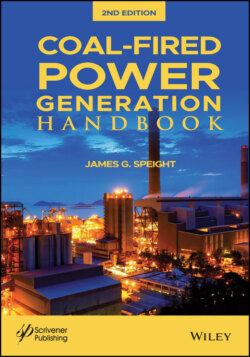Читать книгу Coal-Fired Power Generation Handbook - James Speight G., James G. Speight - Страница 17
1.4.1 Lignite
ОглавлениеLignite (brown coal) is the least mature of the coal types and provides the least yield of energy; it is often crumbly, relatively moist, and powdery. It is the lowest rank of coal, with a heating value of 4,000 to 8,300 Btu per pound (ASTM D388) and is mainly used to produce electricity. With increasing rank (i.e., progressing from lignite to subbituminous coal to bituminous coal to anthracite) the moisture content decreases while the carbon content and the energy content both increase.
Lignite contains the lowest level of fixed carbon (25 to 35%) and highest level of moisture (typically 20 to 40% by weight, but can go as high as 60 to 70%) of all of the coal types (Chapters 2, 5). Ash produced from mineral matter during combustion varies up to 50% w/w. Lignite has low levels of sulfur (less than 1% w/w) and mineral matter (approximately 4% w/w), but has high levels of volatile matter (>32% w/w) and produces high levels of air pollution emissions. Because of its high moisture content, lignite may be dried to reduce moisture content and increase calorific fuel value. The drying process requires energy, but can be used to reduce volatile matter and sulfur as well.
Approximately 7% of coal mined in the United States is lignite and it is found primarily in North Dakota (McLean, Mercer, and Oliver counties), Texas, Mississippi (Kemper County), and to a lesser degree, Montana. The top 10 countries that produce brown coal are (ranked from most to least): Germany, Indonesia, Russia, Turkey, Australia, United States, Greece, Poland, Czech Republic, and Serbia.
With the growing concern for the environment due to emissions from coal utilization, lignite could as well be used in the production of combustible gases (including hydrogen) through underground coal gasification processes (Chapters 9, 10).
